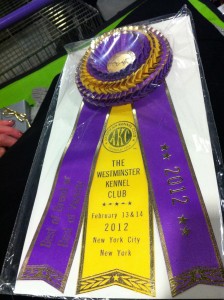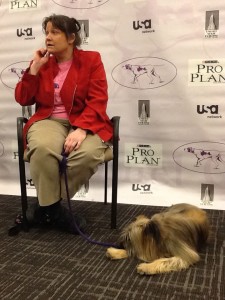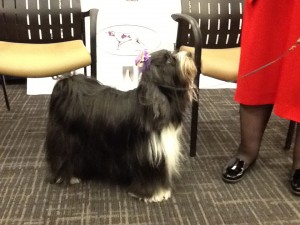 Martha Stewart's Chow Chow, Ghengis Kahn, Wins Best of Breed Ribbon at Westminster 2012
This article originally appeared on petMD News as Newsmakers and Best in Breed Make for an Exciting First Day
The Westminster Kennel Club (WKC) Dog Show gathers prime specimens of pedigreed canines from around the world to compete for the coveted prize of Best in Show. This canine competition, which caters to dog lovers who are seeking a glimpse of their favorite breed, or are striving to better familiarize themselves with the new breeds that have been introduced, is a spectacle like no other. (See 2012’s newest breeds in Meet the AKC’s Six New Breeds).
This, the 136th year of the WKC Dog Show, is my third year attending, so I have a fairly good grasp of the show's flow and am able to focus my attention on the aspects most intriguing to me as a clinical practice veterinarian: canine health and safety, with a touch of celebrity news.
One of the aspects I enjoy about the show is the WKC’s provision of press conferences that feature remarkable stories shared by handlers and their dogs (which provide a strong but silent visual aid). On Monday I sat in on two "news makers" events that featured unique breeds of varying backgrounds — both with compelling tales.
Martha Stewart's Chow Chow, Ghengis Kahn, Wins Best of Breed Ribbon at Westminster 2012
This article originally appeared on petMD News as Newsmakers and Best in Breed Make for an Exciting First Day
The Westminster Kennel Club (WKC) Dog Show gathers prime specimens of pedigreed canines from around the world to compete for the coveted prize of Best in Show. This canine competition, which caters to dog lovers who are seeking a glimpse of their favorite breed, or are striving to better familiarize themselves with the new breeds that have been introduced, is a spectacle like no other. (See 2012’s newest breeds in Meet the AKC’s Six New Breeds).
This, the 136th year of the WKC Dog Show, is my third year attending, so I have a fairly good grasp of the show's flow and am able to focus my attention on the aspects most intriguing to me as a clinical practice veterinarian: canine health and safety, with a touch of celebrity news.
One of the aspects I enjoy about the show is the WKC’s provision of press conferences that feature remarkable stories shared by handlers and their dogs (which provide a strong but silent visual aid). On Monday I sat in on two "news makers" events that featured unique breeds of varying backgrounds — both with compelling tales.
 The first featured Patricia Princehouse, an evolutionary biology and science history educator at Case Western University in Cleveland, OH. Princehouse’s French Great Pyrenees and Pyrenean Shepherds are her breeds of interest in her research on canine evolution. She spoke of how "dogs are an excellent model for research that leads to genetic evaluation of human diseases" and how they "provide a unique source of evidence for testing evolutionary theories."
Present at her side was Zed, the 9-year-old Pyrenean Shepherd. Zed holds honors as a top winner in the history of his breed. The "Pyr Shep," as it is affectionately known, hails from remote areas of the Pyrenees Mountains and is bred to move sheep between valleys in search of better grazing. They are 15-20 inches tall, have a triangular shaped head, and come in multiple colors. The Pyr Shep’s tail is docked or may be natural bobtail, while its ears are cropped straight across. The breed attained AKC recognition in 2009.
The role of the Pyr Shep's in Princehouse’s life goes beyond that of merely providing companionship or opportunities for research. Her personal companion, Shimmer, is trained as a service dog to predict his master’s epileptic seizures. Coincidentally, epilepsy is also a common illness affecting the Pyr Shep, along with hip dysplasia, patella luxation, and ocular abnormalities. Fortunately for Zed, he is healthy and genetically sound, and will soon be retiring from show dog competition to continue his service work and to propagate his good genes through breeding. Zed also does his part in service to others as a therapy dog.
The first featured Patricia Princehouse, an evolutionary biology and science history educator at Case Western University in Cleveland, OH. Princehouse’s French Great Pyrenees and Pyrenean Shepherds are her breeds of interest in her research on canine evolution. She spoke of how "dogs are an excellent model for research that leads to genetic evaluation of human diseases" and how they "provide a unique source of evidence for testing evolutionary theories."
Present at her side was Zed, the 9-year-old Pyrenean Shepherd. Zed holds honors as a top winner in the history of his breed. The "Pyr Shep," as it is affectionately known, hails from remote areas of the Pyrenees Mountains and is bred to move sheep between valleys in search of better grazing. They are 15-20 inches tall, have a triangular shaped head, and come in multiple colors. The Pyr Shep’s tail is docked or may be natural bobtail, while its ears are cropped straight across. The breed attained AKC recognition in 2009.
The role of the Pyr Shep's in Princehouse’s life goes beyond that of merely providing companionship or opportunities for research. Her personal companion, Shimmer, is trained as a service dog to predict his master’s epileptic seizures. Coincidentally, epilepsy is also a common illness affecting the Pyr Shep, along with hip dysplasia, patella luxation, and ocular abnormalities. Fortunately for Zed, he is healthy and genetically sound, and will soon be retiring from show dog competition to continue his service work and to propagate his good genes through breeding. Zed also does his part in service to others as a therapy dog.
 Sydney, the Tibetan Terrier
The second press conference spotlighted the incredible tale of Sydney, a Tibetan Terrier that overcame a life threatening trauma. In 2007, Sydney was happily living the suburban life in Maine with her canine companions. When Sydney failed to return from an outdoor "bathroom break" one day, her owner went in search of her, discovering her in a "field of blood like a scene from Gettysburg." She was rushed to the veterinarian, where she received life saving treatment. The creature that attacked Sydney was unknown until a neighbor reportedly shot and killed a bobcat after an attempted attack was made by the cat on his Springer Spaniels.
The veterinary orthopedic surgeon was concerned that Sydney’s left front leg was so traumatized that an amputation would be necessary. Sydney’s human caretaker was instrumental in saving the limb by providing multiple daily bandage changes and wound flushing. Two surgeries later, Sydney’s "show side" leg was preserved.
Not to be hindered by her trauma, Sydney ultimately won Best in Show 2011 at the Tibetan Terrier Club of America National Specialty. She followed that up with her first award of merit at Westminster 2011. Perhaps her vigorous recovery and awards achievements were due in part to her esteemed lineage. Sydney’s grandmother (Liz) won Best of Breed at Westminster in 2009. Sydney and her owner, Brenda Alger, have since moved onto the safer pastures of Landenberg, PA.
Veterinary medicine was well represented by the University of Pennsylvania School of Veterinary Medicine (Penn Vet). Cindy Otto, DVM, PhD, associate professor and director of the novel, Penn Vet Working Dog Center, was on hand to educate the Westminster audience about the university’s promotion of canine health and human safety.
Penn Vet is developing a novel facility and program where dogs will be bred, raised, and occupationally trained for search and rescue, narcotics detection, and police work. Otto's ultimate goal is to raise dogs that are ideally suited to better our national security and enhance the public’s understanding of the many roles canines play in our communities.
As a 1999 Penn Vet alumnus and member of the Dean's Alumni Council, I'm pleased to see the evolution of the school's involvement in bettering society.
It seems Martha Stewart's catch phrase, "It's a Good Thing," also apply to dogs. Her Chow Chow, Ghengis Kahn (GK), won Best in Breed, but did not place in the top four in the Non-Sporting Group. In response to the award, Stewart said she felt honored, but her motherly pride came across most as she gushed that "was the best." GK is the second of Stewart's chows of the same name, the first having tragically passed away in 2008 in a kennel fire in Pennsylvania.
Greg Kleva, host of the Sirius XM Martha Stewart Radio show, It's a Dog's Life, took me to meet GK in the benching area after his Best in Breed win. Unfortunately, he was in a deep state of post competition slumber, so I didn’t disturb his rest for an introduction. Hopefully, I'll get to meet GK and Stewart next year.
An exciting day ramped up into the evening's Group Judging. However, my top choices didn’t seem to coincide with those of the judges.
Group Judging — Hound Group
My personal favorite was the tall and scruffy Otterhound, who reminds me of my own dog, Cardiff, a Welsh Terrier. I also really liked the Petit Bassett Griffon Hound, who appears as a pleasant combination of scruffy and soft. Another likable breed is the Pharoah Hound, who gave an amusing display of her playfulness on the show floor before she showed.
The Judges' Choices:
1. Wirehaired Dachshund
2. Petit Bassett Griffon Hound
3. Whippet
4. Norwegian Elkhound
Group Judging — Toy Group
Considering my love of scruffy dogs, the Brussels Griffon is highly appealing to me. The Silky Terrier is another preferred pooch, due to its terrier-esque body disguised by flowing grey and brown locks.
The Judges' Choices:
1. Pekingese
2. Affenpinscher
3. Miniature Pinscher
4. Silky Terrier
Group Judging — Non-Sporting Group
I was rooting for Stewart’s Ghengis Kahn, but he was beaten out by my second favorite in the group, the Dalmatian, a breed I have been frequently working with in my veterinary practice.
The Judges' Choices:
1. Dalmatian
2. Chinese Sharpei
3. Lowchen
4. Miniature Poodle
Group Judging — Herding Group
I made personal acquaintance with a Belgian Tervuren and an Entlebucher Mountain Dog (one of the six new breeds for 2012) in the benching area. Despite my enthusiastic cheers, they lost out to more popular group representatives.
The Judges' Choices:
1. German Shepherd Dog
2. Bouvier des Flandres
3. Old English Sheepdog
4. Shetland Sheepdog
At the end of that first day of Westminster 2012, I scampered back to my hotel for some rest before the second day of competition, which included the prestigious Best in Show.
Stay tuned for my notes on Day 2 of the Westminster Kennel Club Dog Show.
Thank you for reading my article. To receive my next article via email, sign up by following this link.
Please feel free to communicate with me through Twitter (@PatrickMahaney) and follow my adventures in veterinary medicine by friending Patrick Mahaney: Veterinarian Acupuncture Pain Management for Your Pets on Facebook.
Copyright of this article (2012) is owned by Dr Patrick Mahaney, Veterinarian and Certified Veterinary Acupuncturist. Republishing any portion of this article must first be authorized by Dr Patrick Mahaney. Requests for republishing must be approved by Dr Patrick Mahaney and received in written format.
Sydney, the Tibetan Terrier
The second press conference spotlighted the incredible tale of Sydney, a Tibetan Terrier that overcame a life threatening trauma. In 2007, Sydney was happily living the suburban life in Maine with her canine companions. When Sydney failed to return from an outdoor "bathroom break" one day, her owner went in search of her, discovering her in a "field of blood like a scene from Gettysburg." She was rushed to the veterinarian, where she received life saving treatment. The creature that attacked Sydney was unknown until a neighbor reportedly shot and killed a bobcat after an attempted attack was made by the cat on his Springer Spaniels.
The veterinary orthopedic surgeon was concerned that Sydney’s left front leg was so traumatized that an amputation would be necessary. Sydney’s human caretaker was instrumental in saving the limb by providing multiple daily bandage changes and wound flushing. Two surgeries later, Sydney’s "show side" leg was preserved.
Not to be hindered by her trauma, Sydney ultimately won Best in Show 2011 at the Tibetan Terrier Club of America National Specialty. She followed that up with her first award of merit at Westminster 2011. Perhaps her vigorous recovery and awards achievements were due in part to her esteemed lineage. Sydney’s grandmother (Liz) won Best of Breed at Westminster in 2009. Sydney and her owner, Brenda Alger, have since moved onto the safer pastures of Landenberg, PA.
Veterinary medicine was well represented by the University of Pennsylvania School of Veterinary Medicine (Penn Vet). Cindy Otto, DVM, PhD, associate professor and director of the novel, Penn Vet Working Dog Center, was on hand to educate the Westminster audience about the university’s promotion of canine health and human safety.
Penn Vet is developing a novel facility and program where dogs will be bred, raised, and occupationally trained for search and rescue, narcotics detection, and police work. Otto's ultimate goal is to raise dogs that are ideally suited to better our national security and enhance the public’s understanding of the many roles canines play in our communities.
As a 1999 Penn Vet alumnus and member of the Dean's Alumni Council, I'm pleased to see the evolution of the school's involvement in bettering society.
It seems Martha Stewart's catch phrase, "It's a Good Thing," also apply to dogs. Her Chow Chow, Ghengis Kahn (GK), won Best in Breed, but did not place in the top four in the Non-Sporting Group. In response to the award, Stewart said she felt honored, but her motherly pride came across most as she gushed that "was the best." GK is the second of Stewart's chows of the same name, the first having tragically passed away in 2008 in a kennel fire in Pennsylvania.
Greg Kleva, host of the Sirius XM Martha Stewart Radio show, It's a Dog's Life, took me to meet GK in the benching area after his Best in Breed win. Unfortunately, he was in a deep state of post competition slumber, so I didn’t disturb his rest for an introduction. Hopefully, I'll get to meet GK and Stewart next year.
An exciting day ramped up into the evening's Group Judging. However, my top choices didn’t seem to coincide with those of the judges.
Group Judging — Hound Group
My personal favorite was the tall and scruffy Otterhound, who reminds me of my own dog, Cardiff, a Welsh Terrier. I also really liked the Petit Bassett Griffon Hound, who appears as a pleasant combination of scruffy and soft. Another likable breed is the Pharoah Hound, who gave an amusing display of her playfulness on the show floor before she showed.
The Judges' Choices:
1. Wirehaired Dachshund
2. Petit Bassett Griffon Hound
3. Whippet
4. Norwegian Elkhound
Group Judging — Toy Group
Considering my love of scruffy dogs, the Brussels Griffon is highly appealing to me. The Silky Terrier is another preferred pooch, due to its terrier-esque body disguised by flowing grey and brown locks.
The Judges' Choices:
1. Pekingese
2. Affenpinscher
3. Miniature Pinscher
4. Silky Terrier
Group Judging — Non-Sporting Group
I was rooting for Stewart’s Ghengis Kahn, but he was beaten out by my second favorite in the group, the Dalmatian, a breed I have been frequently working with in my veterinary practice.
The Judges' Choices:
1. Dalmatian
2. Chinese Sharpei
3. Lowchen
4. Miniature Poodle
Group Judging — Herding Group
I made personal acquaintance with a Belgian Tervuren and an Entlebucher Mountain Dog (one of the six new breeds for 2012) in the benching area. Despite my enthusiastic cheers, they lost out to more popular group representatives.
The Judges' Choices:
1. German Shepherd Dog
2. Bouvier des Flandres
3. Old English Sheepdog
4. Shetland Sheepdog
At the end of that first day of Westminster 2012, I scampered back to my hotel for some rest before the second day of competition, which included the prestigious Best in Show.
Stay tuned for my notes on Day 2 of the Westminster Kennel Club Dog Show.
Thank you for reading my article. To receive my next article via email, sign up by following this link.
Please feel free to communicate with me through Twitter (@PatrickMahaney) and follow my adventures in veterinary medicine by friending Patrick Mahaney: Veterinarian Acupuncture Pain Management for Your Pets on Facebook.
Copyright of this article (2012) is owned by Dr Patrick Mahaney, Veterinarian and Certified Veterinary Acupuncturist. Republishing any portion of this article must first be authorized by Dr Patrick Mahaney. Requests for republishing must be approved by Dr Patrick Mahaney and received in written format.